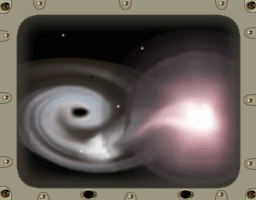Take a Journey of Discovery with RXTE - Classroom Activity

Take out the list of things you observed during your visit to the black hole.
Here are explanations for some of the things you may have observed.
The DroneLight
Time
|
The Companion Star
|
The Singularity ItselfThe black hole itself, the singularity or point with infinite density and gravity, that is the collapsed core of the star, is invisible. Because the gravitational field of the black hole is so strong, the escape velocity, the speed with which something would have to travel to leave the surface of a body, exceeds the speed of light. This means that even light cannot travel fast enough to escape the black hole's grip. But, the grip of black hole does not extend as far as one would think. A black hole is not a cosmic vacuum cleaner. If fact, if our Sun were replaced with a black hole, it would not have an effect on us, gravitationally speaking. This is because the surface of the Sun lies beyond its Schwarzchild radius. This is the radius at which the escape velocity equals the speed of light, and within which the object can no longer be seen. Every object has a Schwarzchild radius - it is simply the radius to which the object would have to be compressed for it to become a black hole. It is proportional to an object's mass. The Schwarzchild radius of the Earth is 1 cm. If the Earth was crushed down to a radius of 1 cm, its escape velocity would be the speed of light. The surface of an imaginary sphere with radius equal to the Schwarzchild radius and centered on a collapsing star is called the event horizon. It defines the region withing which no event can ever be seen, heard, or known by anyone outside it.
But What is Inside?Unfortunately, there is no way to know what is inside the event horizon of a black hole - as observers, the time dilation effect, as well as the gravitational shifting of light, keep us from being able to even watch an object break through the event horizon. If we sent a volunteer astronaut down, it would a one way trip, with no means for him or her to report back. What would they see as they were falling in? Surprisingly, nothing particularly interesting. Images of faraway objects may be distorted in strange ways, since the black hole's gravity bends light, but that's about it. In particular, nothing special happens at the moment when you cross the horizon. Even after you've crossed the horizon, you can still see things on the outside: after all, the light from the things on the outside can still reach you. No one on the outside can see you, of course, since the light from you can't escape past the horizon. Once our astronaut was through the event horizon, they would have to hit the singularity eventually, and before they get there, there will be enormous tidal forces - forces due to the curvature of spacetime - which will squash our astronaut in some directions and stretch them in others until they look like a piece of spaghetti. At the singularity all of present physics is mute as to what will happen, but our astronaut won't care. They'll be dead. |
Want to Know More?
- This list of frequently asked questions (FAQ) has a great
description of what it would be like to jump into a black hole - or
just watch someone else - http://cfpa.berkeley.edu/BHfaq.html
- A higher level FAQ -
http://antwrp.gsfc.nasa.gov/htmltest/gifcity/bh_pub_faq.html
- Imagine the Universe: Black Holes -
http://imagine.gsfc.nasa.gov/docs/introduction/black_holes.html
- How do we see black holes? -
http://wonka.physics.ncsu.edu/~blondin/Blackhole/title.html
and
- Virtual Visit to a Black Hole - http://antwrp.gsfc.nasa.gov/htmltest/rjn_bht.html





